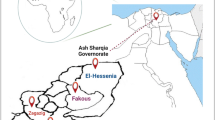Abstract
Cryptosporidium spp. is an important parasitic protozoan causing diarrhea in developing and developed countries. The agent causes severe life-threatening diarrhea especially in immunocompromised hosts. Diagnosis of the Cryptosporidium oocyst in stool samples by conventional microscopy is labor-intensive and time-consuming. Thus, we aimed to evaluate the usefulness of a copro-antigen enzyme-linked immunosorbent assay (ELISA) test in detecting Cryptosporidium spp. from fecal specimens. For this aim, microscopy and specific antigen detection methods were compared to determine Cryptosporidium spp. In addition, specific antigen by ELISA method in stool was investigated in order to find out whether or not it contributes to the diagnosis of Cryptosporidium spp. One hundred and fifty-four stool specimens taken from patients whose ages ranged from 0 to 86 with diarrhea applied to Department of Parasitology, Balcali Hospital of Cukurova University in Adana, Turkey were used. All samples were examined for Cryptosporidium spp. antigen by ELISA and oocysts via gold standard modified acid-fast staining, between October 2008 and July 2009. Eight (5.19%) specimens were found to be positive by modified acid-fast staining method and 37 (24.03%) specimens by copro-antigen ELISA method were found to be positive. The sensitivity and specificity for copro-antigen ELISA were 100% and 80.1%, respectively. The results of copro-antigen ELISA indicate that the simple, rapid, reliable, and standardized immunoassay test is sensitive and specific for routine diagnosis and may be useful for large-scale epidemiological studies of cryptosporidiosis.

Similar content being viewed by others
References
Akısü C, Korkmaz M (2005) Tıbbi Parazitolojide Tedavi. Ed Ozcel MA. Tıbbi Parazitoloji Derneği,Ege Universitesi,Yayın No:20. İzmir, pp 40–41
Altıntas K (1997) Tıbbi Genel Parazitoloji ve Protozooloji. pp 167–170.
Baveja UK (1998) Acid fast staining versus ELISA for detection of Cryptosporidium in stool. J Commun Dis 30(4):241–244
Berger SA (2006) Human parasitic diseases sourcebook. Jones and Bartlett, Massachusetts, pp 116–121
Börekci G, Otag F, Emekdaş G (2005) Mersin’de Bir Gecekondu Mahallesinde Yasayan Ailelerde Cryptosporidium Prevalansı. Infeksiyon Dergisi 19(1):39–46
Chacin-Bonilla L (1995) Cryptosporidiosis in humans. Invest Clin 36(4):207–250
Clark DP, Sears CL (1996) The pathogenesis of cryptosporidiosis. Parasitol Today 12(6):221–222
Current WL, Garcia LS (1991) Cryptosporidiosis. Clin Microbiol Rev 4:225–228
Direkel S, Ozerol IH, Durmaz R (2008) Ishalli Hastalarda Cryptosporidum parvum’un ELISA ve Modifiye Ehrlich-Ziehl-Neelsen Boyama Yöntemleriyle Araştırılması.Mersin Univ. Sağlık Bilim Derg 1:20–25
Dirim D, Turgay N, Alkan MZ (1998) Bir Cryptosporidiosis olgusunun Kinyoun AsitFastBoyasıvePCRileTakibi. Ege Universitesi, Izmir, p 328
Doğan N, Akgün Y (1998) Ishalli Olgularda Cryptosporidium Ookistlerinin Araştırılması. T Parasitol Derg 22(3):243–246
Döskaya M, Dayangac N, Kuman HA (2003) Cryptosporidium parvum. T Paraziol Derg 27(1):64–70
Hashmey R, Simith NH, Cron S, Graviss EA, Chappell CL, White AC (1997) Cryptosporidiosis in Houston, Texas. Medicine(Baltimore) 76(2):118–139
Jayalakshmi J, Appalaraju B, Mahadevan K (2008) Evaluation of an enzyme-linked immunoassay for the detection of Cryptosporidium antigen in fecal specimens of HIV/AIDS patients. Indian J Pathol Microbiol 51(1):137
Kramer MF, Vesey G, Look NL, Herbert BR, Simpson-Stroot JM, Lim DV (2007) Development of a Cryptosporidium oocyst assay using an automated fiber optic-based biosensor. J Biol Eng 1(1):3
Markel EK, Voge M, John DT (1986) Medical parasitology, 6th edn. Saunders, London, pp 72–75
Ozcan K (1998). Tıbbi Parazitoloji Ders ve Laboratuvar Notları, Adan, pp 77–79
Ozcel MA, Özbel Y, Ak M (2007) Ozcel’in Tııbi Parazit Hastalıkları. Tıbbi Parazitoloji Derneği YayınNo:22İzmir,pp363–376.
Saygı G (2002) Temel Tıbbi Parazitoloji. Cumhuriyet Universitesi Yayınları, Ikinci Baskı. pp 94–96
Tabak F (2003) Enfeksiyon Hastalıkları. 2. Baskı, Istanbul. Nobel Tıp Kiabev. pp178
White AC (2006) Infectious Diseases Society of America. Cryptosporidiosis.
Willke TA, Söyletir G, Doğanay M (2002) Infeksiyon Hastalıkları ve Mikrobiyolojisi.pp1919–1920.
Wilson WR (2004) Enfeksiyon Hastalıkları Tanı ve Tedavi. Nobel Tıp Kitabevi. pp 824–827
Acknowledgements
This study was supported by the Cukurova University Research Grant TF.2008.YL.7
Author information
Authors and Affiliations
Corresponding author
Rights and permissions
About this article
Cite this article
Elgun, G., Koltas, I.S. Investigation of Cryptosporidium spp. antigen by ELISA method in stool specimens obtained from patients with diarrhea. Parasitol Res 108, 395–397 (2011). https://doi.org/10.1007/s00436-010-2079-4
Received:
Accepted:
Published:
Issue Date:
DOI: https://doi.org/10.1007/s00436-010-2079-4




